|
|
CCV Mod -- CrankCase Ventilation ModificationMost people consider doing the CCV Mod because they find
oil drips on the driveway from residue running down the back of their 7.3L diesel and dripping to the ground. In less severe
cases, the intercooler boots become saturated with oil mist just to cover them and surrounding areas of the engine with a
dirty grime.
International designed their T444E engines to vent the crankcase gases to atmosphere by rounting the vent
down behind the engine and terminating it there. Ford engineers had a better idea and routed it back into the turbo intake which
without periodic removal of the intake boots and cleaning of the associated parts, leads to oil collecting on the engine and
saturates the boots with oil and increases the chances of blowing a boot off during hard acceleration.
The OEM boots are
made of a material that does not hold up well to petroleum products and once saturated with these vent gasses and oils, quickly
begin to degrade.
Got a question? Contact me on my DieselOrings.com webshop CONTACT PAGE
|
My CCV mod is done and this is how it turned out along with a couple of test pressure measurements taken at the doghouse to see
if excessive crankcase backpressures had developed with this mod. One pressure reading was taken with the
hose vented directly to atmosphere and the other after connecting the vent trap.
I measured .25 inch WC increased pressure with the vent trap connected to the end of the hose near the rear axle.
Now with a few thousand miles of both daily driving or high altitude towing, I find that this small additional backpressure does not
seem to be affecting the operation of the CCV vent in any negitive way.
WARNING: The CCV hose can easily cause a condensation/oil trap if the hose is routed in such a manner
that creates a 'low' spot as the hose folows the frame. If the CCV hose is restricted or blocked, excessive crankcase pressures
will cause seal leaks and potiential seal damage including damange to the turbo seals.
|
|
4" SS exhaust tubing for Intake Vent EliminationWith the factory CCV installation, oily vent gases are directed
into the air intake, about halfway between the air cleaner and
the turbo. The black air intake fitting directly above the driver's side valve cover has a short hose that connects it to the engine's
CCV port and is connected with crimp-style clamps which must be pryed open with a screwdriver to be removed.
Oils in these vent gasses are pulled directly into the turbo and passed to the intercooler system. The oils can saturate
the Y-pipe and intercooler boots and will eventually lead to leakage in these areas.
I used a 3" piece of 4" exhaust left over from my MBRP turbo back system to manufacture a vent eliminator tube. I also used a 4"
constant torque clamp with a short piece of 1/4" aluminum strap attached to the TC clamp to make a rigid mount.
The bracket fastens to the original factory bracket that is mounted on the engine.
The 4" stainless pipe was polished with a polishing wheel and then the edges were sandblasted to give them a little more 'grip'
for the intake boots to clamp to.
|
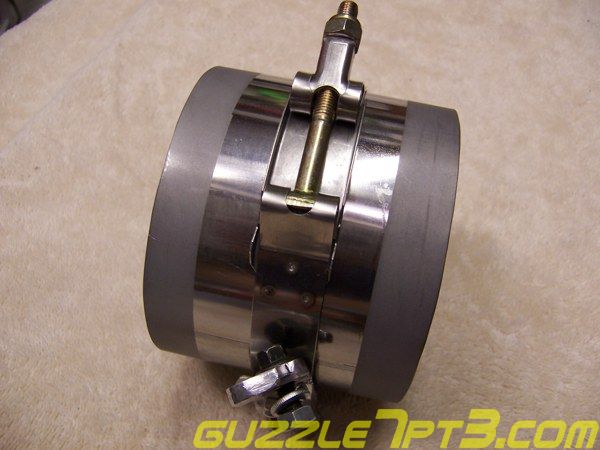
|
SS coupling mounted The CCV eliminator coupling installed in the intake and fastened to the CCV engine bracket.
|
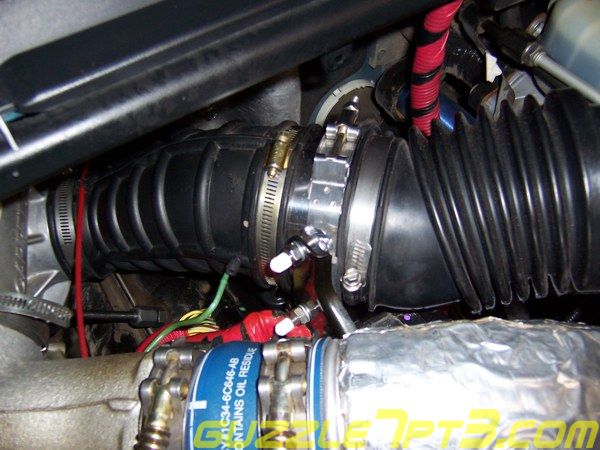
|
Doghouse reversedThe 'doghouse' is the valve cover fitting that Ford uses to vent the engine gases to the
intake. Even though the air intake fitting has been eliminated, the gasses from this fitting must be redirected to the rear of the
truck otherwise the engine will become pressurized and will cause engine seal leakage.
The doghouse is shown in its reversed position to route the hose closer to the firewall area using 3/4 inch Gates heater hose.
Remove the two screws in the top of the cover , lift up the assembly and turn it 180º. There are two o-rings that seal the vent
cover to the valve cover, be careful not to drop these during the reversal process. You may find that the nitrile o-rings that came
factory have swelled and are beginning to disintegrate. My o-rings were pretty soft and squishy so I used
a new set of 4 O-rings from my webshop - DieselOrings.com Reinstall the screws in their original holes.
|
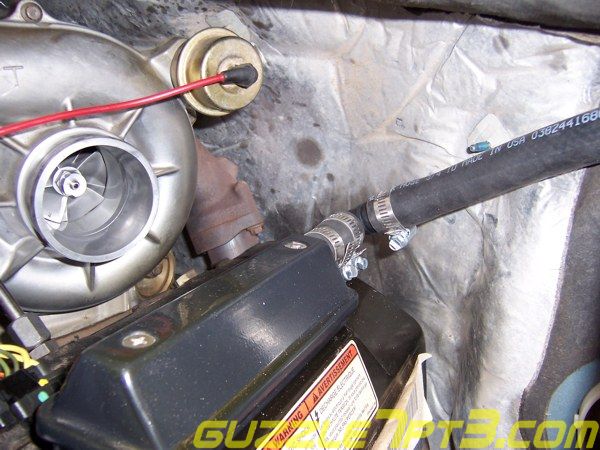
|
Routing the hoseThe CCV exhaust hose was run back to the firewall and over the brake master cylinder. Notice
the upward slope from the CCV housing to the master cylinder. Any immediate condensation of vent gasses occuring in the hose
will drain back to the engine by doing this. From
there, run it straight down and follow the interior of the frame rail, past the fuel pump and fuel tank and cut the hose by the rear axle.
For this installation, 16 ft of hose was used. To run the hose to the rear bumper of an 8 ft bed, 19 ft of hose would be required.
|
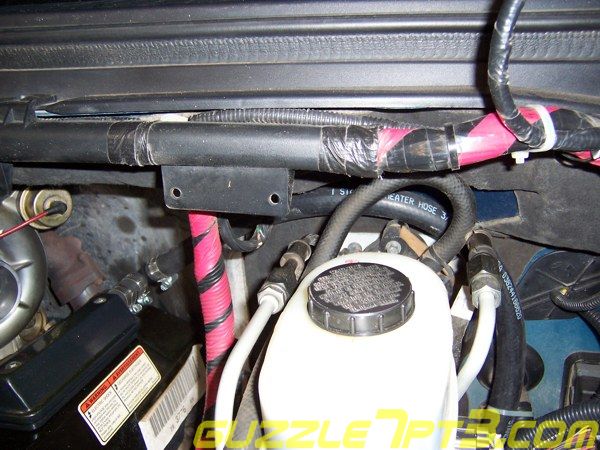
|
Mounting the oil trap The idea behind routing the CCV hose to the rear of the truck is to get the foul smelling CC
vapors as far from the cab as possible. This way you won't have the vapors entering the cab while sitting at a stop light.
The oil trap is mounted on the shroud behind the fuel tank using standoff brackets, wormgear clamps and pop rivets.
To see how I built the oil trap, click HERE.
|
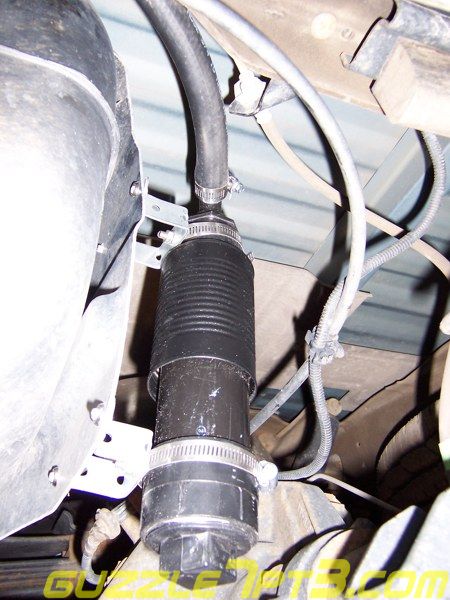
|
Pressure test 1 I wanted to see how much backpressure was present when the hose was vented directly to
atmosphere. The test port was just after the 90º elbow on the CCV doghouse. The water manometer registered right at
.5 inch WC with the engine running at 1200 RPM fast idle.
|
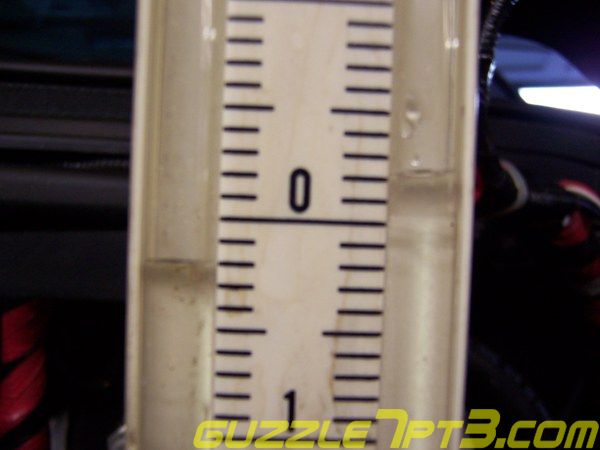
|
Pressure test 2 After installing the oil trap at the end of the hose, I measured the pressure again.
This time the water manometer registered right at .75 inch WC with the engine on a 1200 RPM fast idle. A very slight .25 inch WC
increase.
|
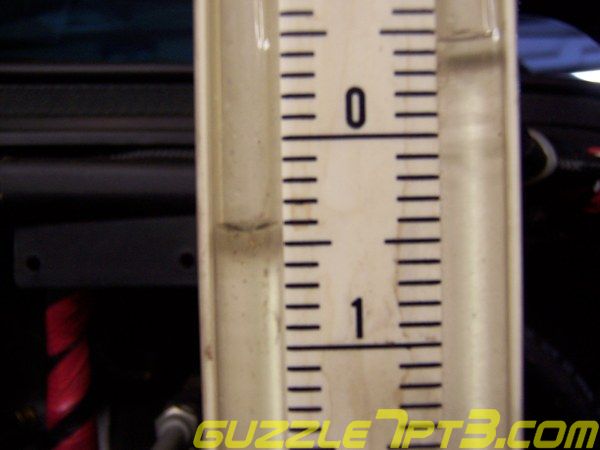
|
Back to guzzle's Powerstroke Modification Index |


